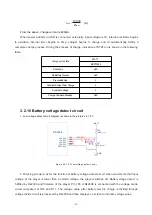
When the time of pressing PLAY button is more than 1 second but less than 4 seconds, pin 57 of
Rk2608 detects he change of voltage; software decides this signal is power-off signal and then saves
contents of machine; pin 58 outputs high level, D12 is on to make Q7 on, VCC is grounded through CE
electrode of Q7, enable end EN is low level, TPS62200 and TPS79333 stop voltage output and the
player realizes software power-off.
When machine down because of software problem, pressing START/PLAY/PAUSE button more
than 4 seconds may realize firmware power-off. The process is: after pressing button, B electrode of Q4
becomes low level, Q4 is on, BATT charges C87 through CE electrode of Q4 and R93, voltage on
capacitor increases gradually to make Q7 on, VCC is grounded through CE electrode of Q7, enable end
EN is low level, TPS62200 and TPS79333 stop voltage output and the player power off. When loosening
button, BATT makes START pin keeps in high level through R89, R90 to make Q5 on, electric charge
saved in C87 discharges quickly through CE electrode of Q5, R22 and R94 to ensure normal power-on
when pressing START/PLAY/PAUSE button next time.
3.2.15 MIC circuit
1. MIC circuit diagram is shown in the picture 3.2.15.1:
2. Working principle: MIC circuit is mainly composed of microphone and MIC bias circuit. MIC1
switches the recorded external voice signals into electric signals to input to ADC circuit of Wm8750 and
switches analog signals into digital signals to form WAV file through software encoding to save inside
FLASH. R27 in circuit is bias resistor of microphone, R6 and C37 constitute filtering circuit to filter the
clutter of audio signals.
Figure 3.2.15.1 MIC circuit diagram
C7
105
MIC1
MICROPHONE
1
2
MIC
R6
47K
R27
2.2K
C37
221
MICBIAS
- 29 -
















































